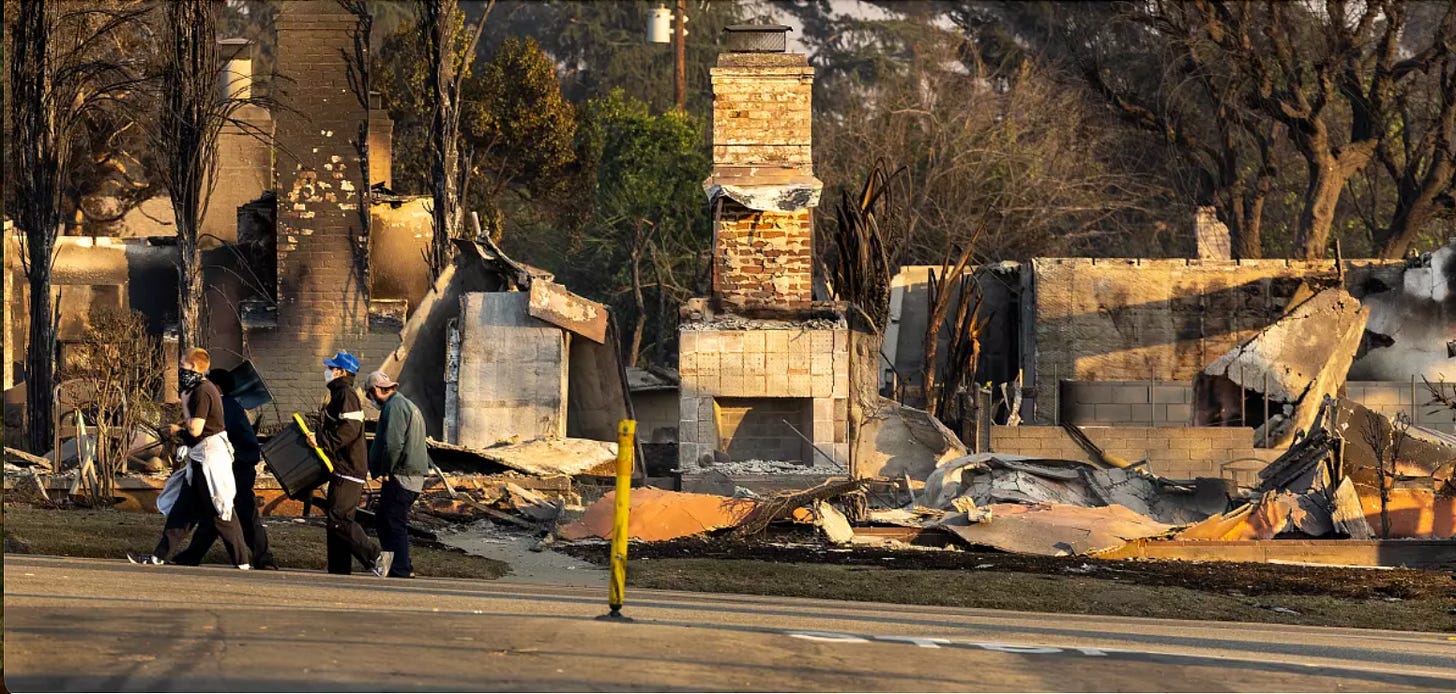The fires in Los Angeles County are the work of myriad factors, some long-standing, others intermittent, many resulting from chance and bad luck. The conflagration, still just partially contained, reminds us that the line between a functioning society and chaos is narrow indeed. For those who’ve lost homes and loved ones, the anarchy of their lives is just beginning.
Routine, regular days for thousands of Angelenos are months, perhaps years away. Multiple schools have been destroyed. The school year will continue, but the affected kids, parents, and teachers are at sea. Classes? Those would be considered a luxury for students and families alike.
Many small businesses in Altadena are smoking ruins. The building owners have lost an asset. The business owners are out their inventory and means of making a living. Their employees are likely out of work, potentially without a home, with only charred rubble to look upon.
Thousands of homes, and all they represent: Childhoods, memories, community, roots, investment, are gone. Whether a multi-million dollar beachside estate or a three bedroom ranch further inland, it will be years before anyone can rebuild, given the nature of the loss, California’s arcane, byzantine, and onerous permitting processes.
Homeowners insurance will provide only minor relief. The delta between what’s covered and current-day replacement cost is likely to leave thousands of homeowners with little more than a check and an empty lot.
Many of the displaced will have to rely on the kindness of friends, family, and strangers to get them through the days to come. Some of those have the financial resources to rent another home or hole-up in a hotel for the timebeing. Regardless, the shock of losing everything isn’t mitigated because room service is available.
The heroic efforts of the ground and air crews battling the fires will be the stuff of legend for their services for years to come. The troubles they’ve faced: low water pressure, looters, and the resurgent Santa Anas are magnified by an official and political response that has been disjointed at best.
As I saw personally in New Orleans immediately after Hurricane Katrina made landfall in 2005, local, state, and even federal structures are not prepared to handle the beyond-worst case scenario. Los Angeles County’s bizarre, interlocking governmental, and quasi-governmental structures have exascerbated the issues.
Did anyone in the Los Angeles Fire Department know the Palisades reservoir had been emptied for repairs? When did the LA Department of Water and Power (LADWP) know that their holding tanks would run low, thereby strangling pressure to hydrants in the firezone? Did anyone in local government heed the fire chief’s December memo alerting them to a $7 million shortfall in overtime pay needed for inspections of fire-prone homes?
To call LA’s water infrastructure rickety is generous. Water systems in Los Angeles and beyond are years behind in basic maintenance, major overhauls and altogether new systems, many not significantly or sufficiently updated since the time of Governor Pat Brown in the 1960s. Numerous recent attempts to increase both supply and transportation have been stymied.
With fires still burning, there are those who’ve stepped up to do more than their part for their friends, neighbors, and complete strangers. As the flames do their best to melt society’s narrow barrier, good samaritans are working to “keep that veneer that does define civilization, stay as polished and beautiful as they can.” (H/T my old man.)
The Santa Anas are forecast to increase significantly over the next 24 hours. When they do, the active fires may grow and new ones may flare up; the firefight is far from over, and the recovery process has yet to begin. When it does, we’ll know better the total scope of the catastrophe.
We have the right to expect our leaders to be competent and decisive in emergencies. When they, too, are overrun, it comes down to us, the indiviual citizens to do what we’ve always done: Come together to provide shelter, comfort, and sustenance, both physical and spritual, for those whose nightmare is just beginning.
News and Notes:
This article from Time Out in LA provides a good list of ways to help, plus things to look out for.
Check out my conversation with Kris Goldsmith, an Army veteran, extremism expert, and CEO of the Task Force Butler Insistute on the latest edition of The Home Front Podcast.






All that is running through my mind at the moment are the lines from the T.S. Eliot poem, "The Hallow Men", that I and my classmates had to memorize in my high school English Lit class: "This is the way the world ends. This is the way the world ends. This the way the world ends. Not with a bang but a whisper."